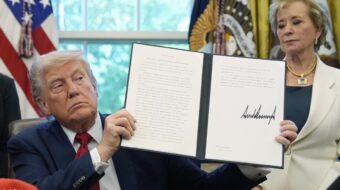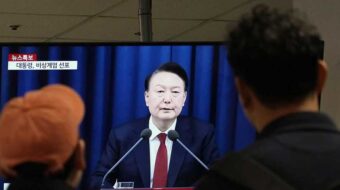
Given the current situation, it is apparent that the Obama administration enters the White House with huge challenges. At the same time, no president in recent memory brings to the job so much popular good will, a Congress dominated by Democrats, an election mandate for progressive change, and an energized movement that supports him.
From what he has said, Obama wants to be a people’s reformer. He has indicated he will make substantive changes in health care, housing, education, retirement security, energy, environment, urban affairs, race and gender relations, foreign relations and popular participation in public affairs. If the last thirty years was an era of people’s retrenchment, Obama envisions the years ahead as an era of substantial people’s reforms. In his view, the boundaries of democracy and reform in a capitalist social formation are elastic and thus can be expanded considerably.
From where will economic growth come?
The Obama administration’s immediate challenge will be to revive the economy. And the overarching question that it will have to answer is: Where will economic dynamism come from in the near term?
We know it won’t come from strapped U.S. consumers whose spending sustained the domestic and global economy over the past decade. We know it won’t come from corporate investment in plant and equipment; instead of expanding investment, corporations are contracting it in the face of overproduction in world commodity markets.
We know it won’t come from the Federal Reserve. The federal fund rate, a rate that governs the Fed’s lending to banks, had is at a record low and might go a little lower but rate cuts so far seem to have had little effect on bank lending and the broader economy.
We know it won’t come from foreign buyers of our exports; they are tightening their belts too. We know it won’t come from the European economies since they are slumping. We know it won’t come from the developing economies whose economic prospects are very gloomy.
Finally, we know it won’t come from speculative excesses and bubbles; that method of stimulating and sustaining aggregate demand has run its course, at least for now.
Government to step in
So to return to the question above: Where will economic dynamism come from in the near term? The answer is massive injection of large amounts of federal dollars to create jobs and stimulate economic activity. China is leading the way with its half trillion-dollar stimulus plan. Hopefully, China’s example will spread to other major economic powers. Given the nature of this crisis and the integration of the world economy, every one of them has to pony up billions and billions of dollars to reflate demand for goods and services at the national and global level.
The Bush administration doesn’t understand this, but the Obama administration does and with Congressional support it will take quick action.
We can expect, and should fully support, an administration stimulus package that includes, among other things, extension of unemployment compensation, assistance to distressed homeowners, aid to states and municipalities, food stamp extension, infrastructure construction and so forth. The only unresolved question is how large a stimulus package. In our view, it should be in the range of a trillion dollars or more.
This, along with assistance (with real strings) to the auto companies and the stabilization and regulation of financial and housing markets, including a moratorium on foreclosures for families in distress, are considered the cornerstones of the administration’s recovery plan. Whether this is enough is unknowable at this point. By January or soon thereafter, more radical measures may be necessary.
Capitalism’s challenges
However, even if these policies are pursued, there is no guarantee that a full-blooded and sustained upswing of the economy will follow. According to conventional wisdom and mainstream economists, high growth rates, near full employment, and healthy profit rates are the normal condition of a capitalist economy. Departures from this norm, it is said, are only passing moments during which capitalism removes barriers to future growth and in so doing creates the conditions for a new expansion that surpasses old peaks in production, employment and profits.
Perhaps that was the case at an earlier stage of capitalism’s development, but there is considerable evidence to question this scenario going forward. Indeed, one has to wonder what the long-run prospects of U.S. and world capitalism are. Was the “golden age” of U.S. capitalism from 1945-1973, during which economic growth rates, investment levels and living standards steadily increased, the rule or the exception to the rule? Will the last thirty years of sluggish and lopsided growth continue, but at a significantly lower level?
Is U.S. capitalism, embedded in an overcrowded and hyper-competitive world economy and restrained by an internal grouping of class and social forces (energy, military, health care, pharmaceutical, financial and other industries), capable of going over to a new and robust growth path, resting on green industry, jobs and technology, on demilitarization, and on rising living standards for working people?
Given the uncertainty of the long-term trajectory of capitalism and the likelihood that the present remedies under consideration will bring only short-term relief, structural reforms of a far-reaching nature and from the bottom up will be necessary if the U.S. economy is to have any chance of resuming a developmental path that is robust and favors the interests of the working class (broadly defined) and its allies – not to mention the planet.
Terrain of struggle
Thus, the Obama administration and the multilayered and multiclass coalition that supports him will almost inevitably have to confront these questions:
• Will the reform and restructuring process only touch the edges of corporate profits and prerogatives or will it make substantial inroads?
• Will government intervention include ownership of an anti-monopoly character or only temporary measures to stabilize turbulent markets?
• Will the counter-crisis spending measures be short term and modest or long term and of sufficient size to sustain a recovery – something that the New Deal never accomplished?
• How far will the reregulation of financial markets go?
Will union rights be marginally improved or greatly strengthened?
• Will trade agreements be renegotiated so that international working class interests are at their core?
• Will bold measures be proposed to achieve equality in conditions of life for racially and nationally oppressed people and women?
• Will public takeover of finance and energy be on the table for discussion?
• Will the reform of housing, education and healthcare be radical in nature? What about the direction of foreign policy and militarism?
• Will the occupation of Iraq be terminated and the Afghanistan conflict resolved in a political and peaceful fashion?
Will capital be rerouted from unproductive consumption (military, parasitic finance and so forth) to productive investment in a green economy and public infrastructure?
And will equitable economic arrangements between U.S. capitalism and the rest of the world be high on the administration’s agenda?
Room for socialist ideas
While this crisis shakes the foundations of capitalism and provokes a working class and people’s response, the room for radical, even socialist ideas, in the public square has grown enormously. Such ideas can be easily discussed with many people and people’s leaders. The force of economic events will compel millions more to consider ideas that in the past were dismissed out of hand. But our vision of socialism will resonate to the degree that it addresses contemporary sensibilities and challenges. It can’t be a redux of 20th century socialism.
Although we are not in the socialist stage of the revolutionary process to be sure, we are on the road, and the only road, to socialism — to a society that is egalitarian in the rough sense, eliminates exploitation of working people, brings an end to all forms of oppression and is notable for the many-layered participation of working people and their allies in the management of the economy and state.
Sam Webb is national chair of the Communist Party USA. This article is based on excerpts from his report to the Nov. 15 National Committee meeting: “A Springtime of Possibility.” To read and download the full report go to: .
Check out the latest from the Communist Party:
“A Landslide Mandate For Change” by Joelle Fishman
“A Springtime of Possibility” by Sam Webb










